2nd KRRC and the 2nd Battle of El Alamein 26-27th October 1942
Len Moore fought with the 2nd Battalion Kings Royal Rifle Corps 2/KRRC across the deserts of North Africa during WW2 from 1941 to 1943. In October 1942 the second Battle of El Alamein battle stared and he was at the front line.
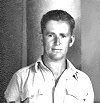
Len Moore 2nd Battalion Kings Royal Rifle Corps
This account of the battle was written by By Lieutenant-Colonel W. Heathcote-Amory of the 2nd Battalion Kings Royal Rifles. - Three of the KRRC Battalions took part in the battle of El Alamein. The 1st, the 2nd, and the recently arrived 11th (former 1st Queen's Westminsters). In the northern sector the 2nd Battalion Kings Royal Rifle Corps was about to be committed to the battle. The Battalion had been fortunate in being withdrawn for reinforcement and training after Alam Halfa.
The 2nd KRRC were part of the 7th Armoured Division and used in the northern attack. The first of the two main actions fought by this Battalion at Alamein was its attack on the "Woodcock" position. This action was going on at the same time as the Rifle Brigade were engaged with "Snipe" with such conspicuous success. "Woodcock" afterwards became officially known as "The Kidney feature".
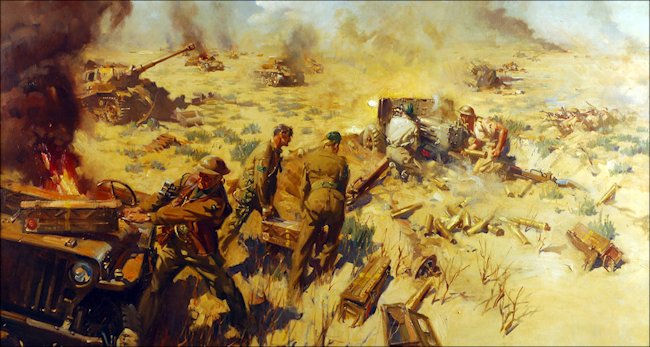
Kidney Ridge action during the battle of El Alamein
Situation on the Morning of 26th October
The position at the German Headquarters should here be noted. General Stumme, acting for General Rommel, had died of a heart attack while carrying out a forward reconnaissance on the first night of the attack, but his body was not found for twenty-four hours. General Rommel, who was recalled from sick-leave, arrived back at the front on the evening of 25 October, having learnt at Rome that virtually none of the fuel he needed had reached North Africa. He appreciated that he must first deal with the salient developing towards Kidney Ridge, which lay north-west of Miteirya Ridge.
However 15 Panzer Division, which had been carrying out continuous local counter-attacks, was already down to thirty-one tanks, and although that Division and Littorio managed to hold the British armour on 26 October, it was clear that it would need a concentration of force in the north for a counter-attack to be effective. Accordingly he decided to order forward 90th Light from its position in reserve on the coast; 21st Panzer and half his artillery were to come up from the south, to which the shortage of fuel would not permit them to return thereafter.
On the British side General Montgomery spent much of 26 October reviewing the situation. 30 Corps had almost completed its tasks, but casualties were mounting, with no available reinforcements in the case of some Commonwealth divisions, and rest was needed. Enemy losses were difficult to assess, and the 10 Corps armour was not out into open country free of mines and anti-tank guns.
He did not want 7 Armoured Division in the south to be worn down in trying to penetrate the minefields. It was left to 10 Corps therefore, while 30 Corps were resting, to improve the salient astride Kidney Ridge, while the R.A.F. continued to wear down the enemy armour. Since our tanks were held up in daylight, it was for the motor battalions of 1st Armoured Division's motor brigade to make night attacks on the enemy strong-points two areas over whose exact locations in this almost featureless stretch of desert 1st Armoured and 51st Highland Division could not agree.
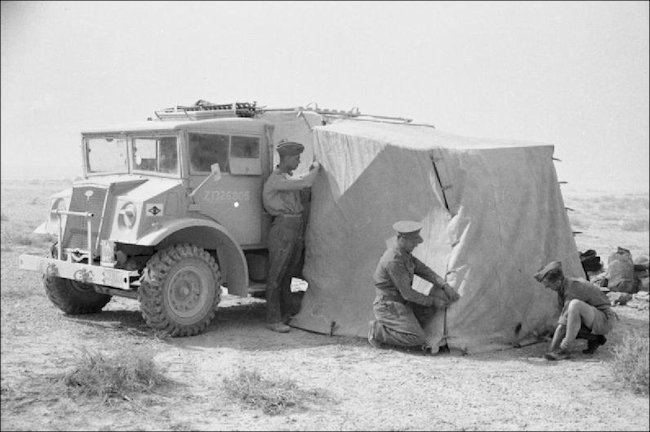
British Bedford 15-cwt truck and tent in the North African Desert war 1942
The 7th Motor Brigade was transferred to 1st Armoured Division, with which the Battalion had originally come out from England and which was in 10 Corps. The Battalion was again reorganized into three Motor Companies and one Anti-tank Company, but the Anti-tank Platoons had been re-equipped with 6-pounder guns which had the necessary weight and power to deal with the German Mark Ill and IV Tanks.
After a short period of rest, Battalion first moved into a tented camp at Khatatba where the technique of passing large forces through minefields were practised and then into the desert for further training. On 22 October the Division moved into the Assembly area for the great battle. It started with a spectacular barrage of First World War dimensions on 23 October but the 7th Motor Brigade was not involved until the 26th.
The first phase of the battle was massive assaults by the Infantry Divisions to 'crumble' the opposing enemy to such an extent that he was forced to deploy his armour in their defence, whilst the British armour was held in reserve to punch a hole through the enemy positions once they had been sufficiently weakened by the infantry attacks. The Battalion therefore was held in reserve, moving forward behind the attacking infantry.
The area was horribly crowded with vehicles of all description, guns of all calibres, echelon vehicles and tanks, all waiting to go forward when the moment came, To the Riflemen, who were used to a daylight dispersion of at least 200 yards between vehicles and considered any other vehicle parking within fifty yards as distinctly unfriendly, inviting as it did almost certain attack from the dreaded Stuka, this close concentration was decidedly uncomfortable and indeed the Battalion suffered some casualties from both shelling and bombing.
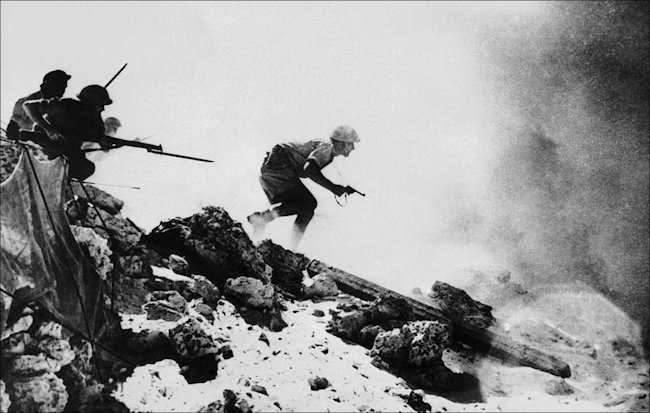
Officer leading from the front at the Battle of El Alamein
Dawn 26th October 1942
The 26th of October found the 2nd Battalion KRRC lying just behind what was originally the enemy's most westerly minefield. During the morning our armour had repeatedly tried to move westwards, but owing to heavy fire from enemy anti-tank guns had failed to make much ground.
By about midday they had succeeded in locating two areas from which most of the fire was coming. These were named by the Brigadier (Jimmy Bosvile, Rifle Brigade) "Woodcock" and "Snipe" and orders were issued for their attack at night. The two attacks were to be simultaneous but quite separate operations, and both supported by 25-pounder and medium artillery.
The Night Attack Plan
The moon was now past its full and rose about 2100 hrs., i.e., two hours after dark. Zero hour was therefore fixed for 2330 hrs. and the line 3,000 yards from the objective. The Commanding Officer decided to motor 2,000 yards, debus and put in the attack on foot, two companies Company (Major Peter Blundell) on the right and B Company (Major Alan Holmes) on the left with A Company (Lieutenant Geoffrey Jameson) in reserve. Each company had anti-tank guns of D Company under command. Artillery concentrations were to come down to cover the debussing and then on to the objective on a timed programme.
The Attack Starts
As the 2nd KRRC crossed the start line there was a splendid moon and visibility quite 200 yards. It was an impressive sight: carriers in front, motor platoons next and mechanized machine-gun trucks and anti-tank gun portees bringing up the rear, all moving on a compass bearing and marching by the centre
After going about three-quarters of the distance, there were sounds indicating that B Company had met with some enemy. This was a surprise, as the area up to the objective was definitely supposed to be clear. However, as -there had been no time or possibility of previous reconnaissance, one was prepared for little things like this, and very soon B Company had picked about a dozen very surprised Germans out of their weapon pits as they went by.
The dust and smoke of the initial concentration could now be seen ahead, but it must have been carried towards us by the wind, because before anything could be done we were in the middle of it, and visibility I dropped to nil. It then seemed to thin a little so the Commanding Officer decided to give the order to debus.
Collision with Enemy Strong-Point
At the same moment anti-tank guns and machine guns suddenly opened up on the leading vehicles at a range of about 75 yards. Immediately several of our vehicles were hit and caught fire. The Commanding Officer's Humber 8-cwt Truck got caught up in the barbed-wire fence protecting the strong-point. It no longer appeared to be the time or the place to debus!
Then followed a hectic time crawling about with wire-cutters trying to find the right wires to cut to release the truck and the precious wireless set, while others were sorting the vehicles out, others returning the fire. The adjutant (Captain Oliver Green-Wilkinson), on the rear link wireless set a little farther back, was being towed round in circles in his efforts to get his vehicle, which had chosen this moment to pack up, going again.
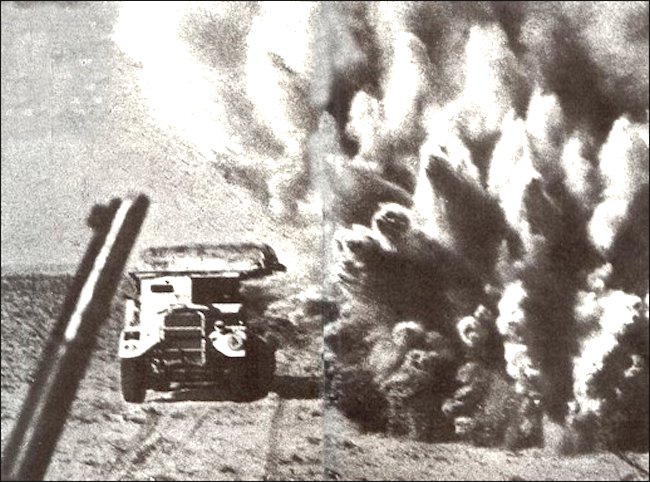
British Bedford Lorry near a German exploding artillery shell
A and B Companies 2nd KRRC Push on
Meanwhile Officer Commanding B Company was trying to get his Company round by the left flank where the ground appeared favourable, but lines of tracer criss-crossing all over the place showed the Hun had got his fixed lines well sited on this flank. This Company then drew back a few hundred yards and re-formed.
Officer Commanding A Company was now reconnoitring the enemy strong-point with a view to attacking it or by-passing it to the right, but almost immediately the welcome news came over the air that C Company had reached the Battalion objective and were reorganizing. Led by Peter Blundell, on foot, they had successfully slipped through on the right and motored right on to the objective, much to the surprise and consternation of the Germans, who for the most part left their positions and took cover in the scrub to the flanks and in rear.
As it appeared unlikely that the rest of the Battalion would be able to get past the strong-point, which was now thoroughly roused, the order was given to move wide to the right flank with a view to coming on to objective from a new direction.
Position Gained by C Company 2nd KRRC
Dawn, however, found this manoeuvre uncompleted, but first light showed that the whole position was in our hands. C Company had wasted no time after getting on to the position and shot up the Hun from all directions to such good purpose that at first light about 100 prisoners were soon being marched back.
The booty included the six offending anti-tank guns and a lot of other weapons and equipment. This method of taking enemy defences by motoring on to them is not recommended as a general rule and would score no marks on a Staff College exercise but it shows what can be done by surprise tactics especially if the surprise is equally divided between friend and foe alike.
During the course of the morning the rest of the Battalion joined C Company on the position, which was held all that day and the next night. A large number of enemy tanks kept hovering about the position and several times it looked as though they were going to attack. They obviously did not know who or what we were, and after we had knocked out a couple at extreme range they drew off, and the threat came to nothing.
During the next night one enemy tank drove slowly into the Battalion position and gave itself up, much to the astonishment of everyone. A Rifleman drove it about in rear of our position next morning but frightened so many of our friends that we had to destroy it. We then handed this position over to another formation. This method of taking enemy defences by motoring on to them is not recommended as a general rule and would score no marks on a T.E.W.T., but it shows what can be done by surprise tactics get him guessing and the battle is half won, especially at night.
Everyone was splendid, and the Riflemen were at the top of their form. but as separate operations. The Battalion was given the left objective where the track ran just east of the Tel el Aqqaqir feature, which was a slight rise in the ground overlooking the track from the west.
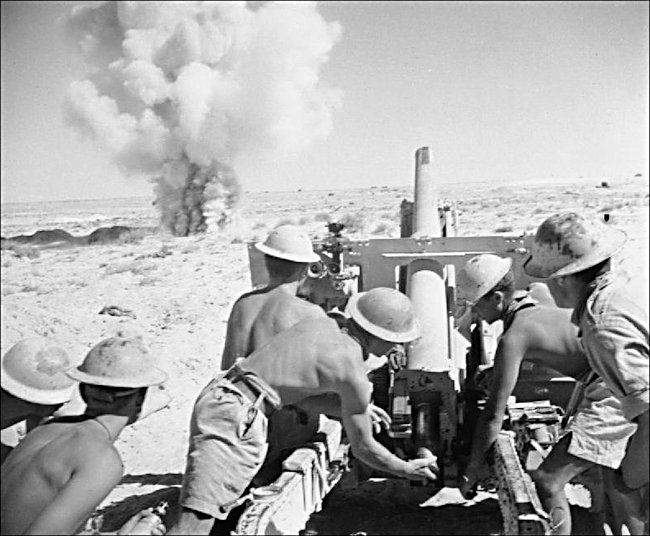
25pdr gun artillery fire at the Battle of El Alamein
Plan and Orders
The attack was to be supported by a concentration of 25-pounder and medium artillery fire, and zero hour was just after moonrise at about 0130 hrs, 3rd November. The moon was now in its last quarter and gave an almost ideal light for an operation of this nature, although its late rising made the time available for bringing up the anti-tank guns and digging in before first light all too short.
Owing to casualties in officers and men, and especially in vehicles, the Battalion was now operating on a three-company basis, two motor companies and an anti-tank company, and B Company (Major Alan Holmes) was being reinforced and re-equipped in the Brigade echelon area. The Commanding Officer therefore decided to attack with one company up, C Company (Major Peter Blundell), and A Company (Captain Jimmy Lees) in reserve.
This Company had during the day (2nd November) had many casualties in its Scout Carrier Platoon, losing both its Commander (Lieutenant Jameson), wounded, and its platoon sergeant (Sergeant Philp) and several carriers. This platoon was therefore left out of this action.
Most of this distance was to be covered on foot, accompanied by the carriers of C Company and a carrier containing the Commanding Officer's charger wireless set. A liaison officers of Battalion Headquarters accompanied the Commanding Officer on foot with A Company Headquarters.
The remainder of the fighting vehicles of both companies followed behind the reserve company. One battery, Anti-Tank Regiment, R.A., was under command of the Battalion for this action. Battalion Headquarters, D Company and this anti-tank battery were to remain on the start line under the acting Battalion Second-in-Command (Major D. Graham-Campbell) until called up on to the position. The Battalion therefore formed up on the start line at last light and then bedded down for a few hours of much needed sleep.
The Attack
At 0130 hrs. the two motor companies and Battalion Advanced Head-quarters were on the move. Soon the objective was easily picked out by our bursting shells and the white Very lights put up by the enemy. The going was good and unexpectedly soon the poles of the telephone line which ran along the track could be occasionally seen against the sky. The leading company then came up against opposition, and heavy machine-gun fire was opened on them from about the Iine of the track.
In spite of this the leading platoons pushed on and reached the line of the track, the platoon on the left going on to the edge of the broken ground west of the track. Both these platoons had by now suffered a lot of casualties. The commander of the right platoon (Lieutenant Cumming) had been killed.
The Carrier Platoon (Lieutenant D. Colman) now went forward to reconnoitre west of the track. Colman took one section with him and return reported that the enemy appeared to have withdrawn into the broken ground well to the west of the track. He had been fired on several times from either well-concealed machine-gun positions or, more probably, dug-in tanks. There were no enemy left east of the track. He brought in one German and one Italian prisoner and reported five large lorries abandoned just west of the track.
Consolidation
As the Battalion had now reached its objective and the remaining hours of darkness were all too few, the Commanding Officer ordered companies to dig in where they were and C Company to withdraw their left platoon back across the road where they could be supported by the reserve, A Company. The Company Sergeant-Major (Cooper) now reported that Major Blundell had been badly wounded and had been sent back to the Regimental Aid Post in a carrier.
Lieutenant R. Nixon then assumed command of the Company. Two troops of anti-tank guns were sent for and quickly came up and dug in on the position. It appeared inadvisable at the time to bring up any more anti-tank guns as the position was, owing to the nature of the ground, very narrow and overlooked from the rising ground to the west of the track, making defilade positions impossible. There was not therefore room to use more than eight guns at the most.